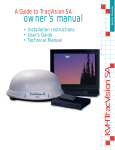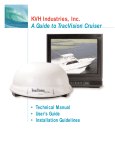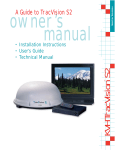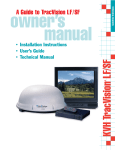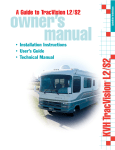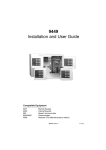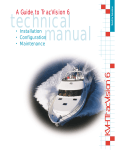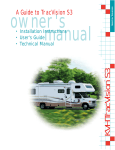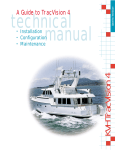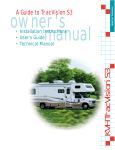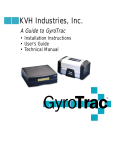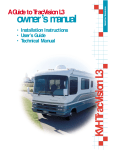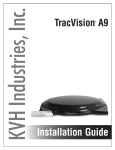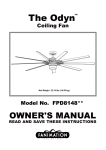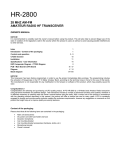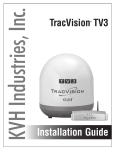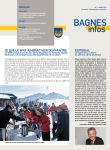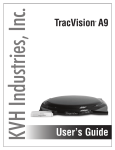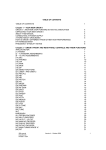Download TracVision SA User Manual
Transcript
KVH Industries, Inc. A Guide to TracVision SA • Installation Instructions • User’s Guide • Technical Manual Congratulations! You have selected one of the most advanced land-mobile satellite tracking systems available today. KVH® Industries’ TracVision® SA is designed for use with DIRECTV® and the DISH™ Network. This manual provides detailed instructions on the proper installation, use, and maintenance of your TracVision SA system. Throughout this manual, important information is marked for your attention by these icons: A helpful tip that either directs you to a related area within the manual or offers suggestions on getting the highest quality out of your system. An alert to important information regarding procedures, product specifications, or product use. Information about installation, maintenance, troubleshooting, or other mechanical issues. An electrical safety warning to help identify electrical issues that can be a hazard to either this KVH product or a user. Direct questions, comments, or suggestions to: KVH Industries, Inc. 50 Enterprise Center Middletown, RI 02842 USA tel: +1 401 847-3327 fax: +1 401 849-0045 e-mail: [email protected] internet: http://www.kvh.com KVH Part # 54-0149 B © 2000, KVH Industries, Inc. TracVision SA Serial Number This serial number will be required for all troubleshooting or service calls made regarding this product. TracVision® and KVH® are registered trademarks of KVH Industries, Inc. DIRECTV® is an official trademark of DIRECTV, a unit of GM Hughes Electronics Corporation. DISH™ Network is an official trademark of EchoStar Communications Corporation. Table of Contents 1 Introduction . . . . . . . . . . . . . . . . . . . . . . . . . . . . . . .1-1 1.1 Digital Satellite Television . . . . . . . . . . . . . . . . . . . . . . . . . . . . . .1-1 1.2 TracVision SA System Overview . . . . . . . . . . . . . . . . . . . . . . . .1-1 1.2.1 TracVision SA Components....................................................1-2 1.2.2 Integrated Receiver Decoder..................................................1-2 1.3 Materials Provided with TracVision SA . . . . . . . . . . . . . . . . . . . .1-3 1.3.1 Additional Materials Required for TracVision SA Use ............1-3 2 Installation . . . . . . . . . . . . . . . . . . . . . . . . . . . . . . . .2-1 2.1 Overview of Installation . . . . . . . . . . . . . . . . . . . . . . . . . . . . . . .2-1 2.1.1 Installation Tools and Materials Required...............................2-1 2.1.2 Kitpack ....................................................................................2-2 2.2 Choosing the Best Location . . . . . . . . . . . . . . . . . . . . . . . . . . . .2-2 2.3 Mounting the Antenna Unit . . . . . . . . . . . . . . . . . . . . . . . . . . . . .2-2 2.4 Connecting the Antenna Unit . . . . . . . . . . . . . . . . . . . . . . . . . . .2-6 2.4.1 Connecting the Antenna Data Cable to the IRD ....................2-8 2.4.2 Connecting the Antenna to Vehicle Power ...........................2-10 2.4.3 Connecting the Antenna RF Signal Cable to the IRD ..........2-11 2.5 Checking Out the System . . . . . . . . . . . . . . . . . . . . . . . . . . . . .2-13 2.6 Completing the Installation Process . . . . . . . . . . . . . . . . . . . .2-14 2.7 Configuring TracVision SA for Remote Satellite Dish Operation . . . . . . . . . . . . . . . . . . . . . . . . . . . . . .2-14 3 Operation . . . . . . . . . . . . . . . . . . . . . . . . . . . . . . . . .3-1 4 Troubleshooting . . . . . . . . . . . . . . . . . . . . . . . . . . . . .4-1 4.1 Causes and Remedies for Common Operational Issues . . . . . .4-1 4.1.1 Blown Fuse or No Power........................................................4-2 4.1.2 Satellite Signal Blocked ..........................................................4-2 4.1.3 Outside Satellite Coverage Zone ...........................................4-2 4.1.4 Incorrect or Loose RF Connectors .........................................4-2 54-0149 Rev. B i 4.2 IRD Troubleshooting . . . . . . . . . . . . . . . . . . . . . . . . . . . . . . . . . .4-3 4.2.1 IRD Data Port or Cable/Wiring ...............................................4-3 4.2.2 AC Power Fluctuating.............................................................4-3 4.2.3 EchoStar IRD Commissioning Check.....................................4-3 4.2.4 Failed IRD Status Check ........................................................4-3 4.2.5 IRD Faulty...............................................................................4-4 4.3 LNB Faults . . . . . . . . . . . . . . . . . . . . . . . . . . . . . . . . . . . . . . . . . .4-4 4.4 Computer Diagnostics . . . . . . . . . . . . . . . . . . . . . . . . . . . . . . . .4-5 4.5 Maintenance Port Parser Commands . . . . . . . . . . . . . . . . . . . . .4-5 5 Maintenance . . . . . . . . . . . . . . . . . . . . . . . . . . . . . . .5-1 5.1 Warranty/Service Information . . . . . . . . . . . . . . . . . . . . . . . . . . .5-1 5.2 Preventive Maintenance . . . . . . . . . . . . . . . . . . . . . . . . . . . . . . .5-1 5.3 Replaceable Parts . . . . . . . . . . . . . . . . . . . . . . . . . . . . . . . . . . . .5-2 5.4 Field Replaceable Unit Procedures . . . . . . . . . . . . . . . . . . . . . .5-3 5.4.1 PCB Removal and Replacement............................................5-5 5.4.2 RF Detector ............................................................................5-6 5.4.3 Antenna LNB Replacement ....................................................5-6 5.4.4 EchoStar Adapter Replacement .............................................5-8 5.5 ii Preparation for Shipment . . . . . . . . . . . . . . . . . . . . . . . . . . . . . .5-8 Appendix A System Specifications . . . . . . . . . . . . . . . . . .A-1 Appendix B Functional Block Diagram . . . . . . . . . . . . . . . .B-1 Appendix C Data Cable Wiring . . . . . . . . . . . . . . . . . . . . .C-1 C.1 Wiring TracVision SA to a 15-pin Data Connector . . . . . . . . . . .C-1 C.2 DB9 Data Connector Pin Assignments . . . . . . . . . . . . . . . . . . .C-2 Appendix D EchoStar IRD Commissioning Procedure . . . . . .D-1 Appendix E Startup Data Sequence . . . . . . . . . . . . . . . . . .E-1 Appendix F Maintenance Port Parser Commands . . . . . . . . .F-1 F.1 System Commands . . . . . . . . . . . . . . . . . . . . . . . . . . . . . . . . . . .F-1 F.2 Manual Positioning Commands . . . . . . . . . . . . . . . . . . . . . . . . .F-2 F.3 Operational Commands . . . . . . . . . . . . . . . . . . . . . . . . . . . . . . .F-3 F.4 Target and Signal Commands . . . . . . . . . . . . . . . . . . . . . . . . . .F-4 List of Figures Figure 1-1 TracVision SA System Configuration . . . . . . . . . . . . . . . . .1-1 Figure 1-2 Primary Components of the TracVision SA . . . . . . . . . . . .1-2 Figure 2-1 Proper Orientation of the Antenna Unit . . . . . . . . . . . . . . .2-3 Figure 2-2 Forward Shipping Restraint (Arranged for Shipping) . . . . .2-3 Figure 2-3 TracVision SA Shipping Restraints (Top View) . . . . . . . . .2-3 Figure 2-4 Mounting the Unit on a Curved Surface . . . . . . . . . . . . . .2-4 Figure 2-5 Baseplate Dimensions . . . . . . . . . . . . . . . . . . . . . . . . . . .2-4 Figure 2-6a Connectors Facing Rear of Vehicle – Factory-drilled Drain Hole Locations . . . . . . . . . . . . . . . . .2-5 Figure 2-6b Connectors Facing Front of Vehicle – Recommended Drain Hole Locations . . . . . . . . . . . . . . . .2-5 Figure 2-7 Forward Shipping Restraint Storage . . . . . . . . . . . . . . . . .2-6 Figure 2-8 Proper Wire-to-Terminal Connection . . . . . . . . . . . . . . . . .2-6 Figure 2-9 Moving the Antenna Reflector . . . . . . . . . . . . . . . . . . . . . .2-7 Figure 2-10 Cable Port Assignments (Exterior of Baseplate) . . . . . . . .2-7 Figure 2-11 Cable Overlap within the TracVision SA Baseplate . . . . . .2-7 Figure 2-12 Proper Terminal Strip Wiring Arrangement – Data Cable . . . . . . . . . . . . . . . . . . . . . . . . . . . . . . . . . . . .2-8 Figure 2-13 DB9 Connector . . . . . . . . . . . . . . . . . . . . . . . . . . . . . . . .2-8 Figure 2-14 EchoStar Adapter Installation . . . . . . . . . . . . . . . . . . . . . .2-9 Figure 2-15 Proper Wire-to-Terminal Connection . . . . . . . . . . . . . . . .2-10 Figure 2-16 Proper Terminal Strip Wiring Arrangement – Power Cable . . . . . . . . . . . . . . . . . . . . . . . . . . . . . . . . .2-10 Figure 2-17 Wiring TracVision SA to Vehicle Power . . . . . . . . . . . . . .2-11 Figure 2-18 Connecting the RF Cable to TracVision SA . . . . . . . . . . .2-11 54-0149 Rev. B iii Figure 2-19a-d Attaching the KVH-provided F-connector to an RF Cable . . . . . . . . . . . . . . . . . . . . . . . . . . . . . . . .2-12 Figure 2-20 Remote Dish Wiring Configuration . . . . . . . . . . . . . . . . .2-14 Figure 5-1 Antenna, PCB, and Rotating Plate . . . . . . . . . . . . . . . . . .5-3 Figure 5-2 Close-up of Linear Actuator, Pivot Bracket, and Pin . . . . .5-3 Figure 5-3 Antenna Assembly . . . . . . . . . . . . . . . . . . . . . . . . . . . . . .5-4 Figure 5-4 Close-up of RF Detector, PCB, and Cover . . . . . . . . . . . .5-4 Figure 5-5 PCB Connector Locations – Rear View (not to scale) . . . .5-5 Figure 5-6 Attaching the Shipping Restraints to the Antenna Baseplate . . . . . . . . . . . . . . . . . . . . . . . . . . . . . .5-9 Figure 5-7 Securing the Forward Shipping Restraint . . . . . . . . . . . . .5-9 Figure C-1 DB9 Male and Female Connector Arrangement . . . . . . . .C-2 List of Tables iv Table 1-1 TracVision SA Packing List . . . . . . . . . . . . . . . . . . . . . .1-3 Table 2-1 Kitpack Contents . . . . . . . . . . . . . . . . . . . . . . . . . . . . . .2-2 Table 2-3 DSS On-screen Messages . . . . . . . . . . . . . . . . . . . . .2-13 Table 2-2 TracVision SA Operational Messages . . . . . . . . . . . . .2-13 Table 3-1 TracVision SA Automated Procedures . . . . . . . . . . . . . .3-1 Table 4-1 Troubleshooting Matrix . . . . . . . . . . . . . . . . . . . . . . . . .4-1 Table 5-1 Field Replaceable Units . . . . . . . . . . . . . . . . . . . . . . . .5-2 Table A-1 TracVision SA System Specifications . . . . . . . . . . . . . .A-1 Table C-1 Alternate Wiring Arrangement for TracVision SA Data Cable to DB15 (15-wire) Connector . . . . . . . . . . .C-1 Table C-2 DB9 Pin Functions and Color Code . . . . . . . . . . . . . . .C-2 Table F-1 System Commands . . . . . . . . . . . . . . . . . . . . . . . . . . . .F-1 Table F-2 Manual Positioning Commands . . . . . . . . . . . . . . . . . . .F-2 Table F-3 Operational Commands . . . . . . . . . . . . . . . . . . . . . . . .F-3 Table F-4 Target and Signal Commands . . . . . . . . . . . . . . . . . . . .F-4 Introduction 1 Introduction 1.1 Digital Satellite Television The DIRECTV® and DISH™ Network systems transmit digital audio and video data from land-based transmitters to a satellite “parked” above the equator. Each satellite relays the signals in spot beams covering the continental United States and contiguous waters. TracVision SA automatically identifies, locks on to and receives signals from the appropriate satellite when your vehicle is stationary. 1.2 TracVision SA System Overview TracVision SA is a self-acquiring satellite TV antenna for use when your vehicle is stationary. The system is not designed to track the TV satellite when the vehicle is moving. A complete satellite TV system includes the TracVision SA connected to an Integrated Receiver Decoder (IRD), aka a “satellite receiver,” and a television set. A desktop or laptop computer is used to conduct diagnostics. The interrelationship of units is illustrated in Figure 1-1. System specifications and a functional block diagram are provided in Appendices A and B, respectively. Figure 1-1 TracVision SA System Configuration 11-16 Volts DC 2.5-3.5 Amps Co-axial Cable Low-speed Data Port Satellite Receiver 9-Pin PC Communications Port TracVision SA is equipped with a single-port Low Noise Block (LNB) that can provide signals to a single IRD. Should you wish to equip your vehicle with multiple TVs and IRDs, a dual-port LNB is available as an option (KVH Part Number 19-0056). Television Options Purchased Separately 54-0149 Rev. B 1-1 A Guide to TracVision SA 1.2.1 TracVision SA Components The Antenna Unit includes the antenna positioning mechanism, signal front end, power supply and control elements. These include antenna drive controls and mechanisms, the cable wrap subassembly, power conditioning and regulating circuits, and the RF detector. The antenna is a parabolic dish mounting a singleport low noise block (LNB) converter with built-in preamplifier. A molded ABS radome encloses the baseplate and is secured in place with standard fasteners. Liquid-tight (watertight) fittings located on the back of the baseplate join the power, signal, and control cabling from below-decks units. Figure 1-2 Primary Components of the TracVision SA Radome Antenna Reflector Always lift the antenna unit by the gray baseplate and not the radome, antenna reflector, or internal mechanical assemblies. NEVER pick up the unit by the LNB! LNB Antenna Unit Mounting Plate 1.2.2 Integrated Receiver Decoder On-screen messages are not available with a DISH Network IRD. 1-2 The IRD receives satellite signals from the Antenna Unit for signal decoding, processing and channel selection, and sends the signals to the TV set for viewing. Messages are sent from the IRD to the Antenna Unit and messages are received from the Antenna Unit for display on the television screen. The IRD also provides the interface for the user to activate authorization for reception. Please refer to the User’s Manual provided with your selected IRD for complete operating instructions. Introduction 1.3 Materials Provided with TracVision SA Table 1-1 lists the units, cables, and materials packed in the TracVision SA package by name and KVH part number. Component KVH Part No. Antenna Unit (comprising): 01-0225-02 Baseplate Assembly 02-0952-02 Radome Assembly 02-0953-02 RF Cable (30') 32-0589-30 Power Cable (30') 32-0590-30 Data Cable (30') 32-0591-30 Mounting Plate 20-0668 Kitpack* 72-0094 Installation and Operation Manual 54-0149 Table 1-1 TracVision SA Packing List Cables for the TracVision SA are stored beneath the antenna unit during shipping. * A complete listing of kitpack contents is provided in Section 2.1.2, “Kitpack.” 1.3.1 Additional Materials Required for TracVision SA Use To make full use of your new TracVision SA and receive satellite TV on the road, you will need to provide/purchase the following: • Television • Appropriate IRD for your selected satellite TV service (if using the DISH Network, a Model 4000 or 5000 IRD will be required) • Sealing materials to weatherproof cable holes and seal mounting plate • Optional KVH EchoStar Adapter (for use with the DISH Network service and IRD) 54-0149 Rev. B Operation of the DISH Network requires the purchase of an EchoStar IRD Adapter. To purchase an EchoStar Adapter, contact KVH or your local KVH dealer and ask for KVH Part Number 02-0899. 1-3 Installation 2 Installation 2.1 Overview of Installation TracVision SA is designed for simple installation and setup. Just follow these easy steps: 1. Choose the antenna location. 2. Mount the antenna unit. 3. Connect the antenna unit cables. 4. Connect the antenna unit to the TV IRD. Plan the entire installation before proceeding! Take into account component placement, running cable distances between units, and accessibility to the equipment after installation. 5. Connect the TV IRD to the TV. 2.1.1 Installation Tools and Materials Required • Electric drill • 3 • 1 • #2 Phillips and #0 flat tip screwdrivers • Augat Snap ‘n Seal Crimp/Strip Tool (Part Number IT1000) if using the KVH-provided F-connector • Silicone sealant or RTV • Thread locker (as required) • 7 • Wire strippers • Adhesive suitable for specific roof construction and materials (e.g., butyl rubber adhesive tape or other liquid adhesive) • Rivet Gun and 3⁄16”-rivets (or other fastener suitable for specific roof construction) • Terminal crimp tool • Optional PC with terminal emulation software such as PROCOMM, Windows Terminal, or Windows 95 Hyperterminal ⁄16”-drill bit and 1⁄2” hole saw ⁄2”-socket wrench The product serial number may be found in front of the antenna reflector on the rotating plate as well as on the inside front cover of this manual. ⁄16”-open end wrench 54-0149 Rev. B While some DIRECTV IRDs offer on-screen messages, it is recommended that a PC be available for all installations of both DIRECTV and EchoStar. 2-1 A Guide to TracVision SA 2.1.2 Kitpack Table 2-1 lists the materials provided in the TracVision SA kitpack. Table 2-1 Kitpack Contents Part Qty. Rocker Switch 1 12-0048 Switch Plate 1 19-0167 RF F-Connector 2 23-0170 Terminal Crimp (female) 5 23-0188-03 ⁄4˝-20 x 5⁄8˝ hex screws 4 14-0250-0010 1 ⁄4˝ flat washers 4 14-0251 Tie-wraps 5 22-0013 Flash kit cable and adapter 1 02-1029 1 2.2 The liquid-tight connectors on TracVision SA may face either forward or backward along the centerline of the vehicle for more convenient installation. KVH Part No. Choosing the Best Location • The ideal antenna site has a clear view of the horizon/satellite all around. • Keep the antenna clear of any obstructions on the roof (e.g., air conditioners). • Consider the location of the antenna relative to the location of any equipment or necessary wiring within the vehicle. • For best operation, mount the antenna on a horizontal surface. 2.3 Mounting the Antenna Unit 1. Remove antenna unit from shipping container. Always lift the antenna unit by the gray baseplate, never by the radome or any portion of the antenna assembly! 2. Remove and save the 8 pan head screws and sealing washers that hold radome to baseplate. Carefully lift radome straight up until clear of antenna assembly and set aside. 3. Position antenna unit in desired location on the centerline of the vehicle with baseplate and mounting plate arrows facing in the same direction (either forward or backward). The proper orientation is illustrated in Figure 2-1 on the following page. 2-2 Installation Figure 2-1 Proper Orientation of the Antenna Unit icle Vehnterline Ce 4. While the baseplate is in place, mark location(s) on roof for cable access to permit convenient cable access to the liquid-tight fittings on the back of the baseplate. 5. Cut tie-wraps holding antenna unit to the forward shipping restraint. 2 tie-wraps used Forward Shipping Restraint to secure LNB arm Nuts and Washers Do not discard the shipping restraints, washers, or the nuts. Save them for future use in case the antenna unit needs to be removed and shipped to another location. Four 1⁄4˝-20 x 5⁄8˝ hex head screws have been provided in the kitpack for shipping as the bolts used to hold the shipping restraint during initial shipping are integral parts of the mounting plate. Figure 2-2 Forward Shipping Restraint (Arranged for Shipping) Forward Shipping Restraint 6. Remove additional nuts and washers connecting baseplate and shipping restraints to the mounting plate. The positions of all three shipping restraints are pictured in Figure 2-3. Figure 2-3 TracVision SA Shipping Restraints (Top View) Rotating Plate Shipping Restraint Forward Shipping Restraint for LNB Bracket Rotating Plate Shipping Restraint 54-0149 Rev. B 2-3 A Guide to TracVision SA 7. Remove antenna unit from mounting plate. 8. The mounting plate allows the antenna unit to be mounted on a curved roof. While the perimeter of the mounting plate is secured to the vehicle with the appropriate fasteners, two flexible wings allow the rear mounting bolts to attach to the antenna baseplate. These may be angled upward to ensure a secure mounting, as shown in Figure 2-4. Antenna Baseplate bolts to this “wing,” which can remain horizontal. Figure 2-4 Mounting the Unit on a Curved Surface Mounting Plate Wing Mounting Plate can be tightened down to conform to a curved surface. 9. Using the mounting plate as a template, drill twenty-three 3⁄16”-holes through roof of vehicle. Remove plate and clean roof surface. The dimensions of the baseplate are shown in Figure 2-5. Figure 2-5 Baseplate Dimensions 28.8" 24.0" 2-4 Installation 10. Place a strip of black butyl rubber adhesive or an equivalent over all holes. If using a liquid construction adhesive, apply bead to mounting plate in a zig-zag pattern. 11. Reposition mounting plate over tape/adhesive and attach using 3⁄16”-diameter rivets (or appropriate fasteners). Seal all rivet heads and edges with silicone. 12. Drill cable access hole(s) in vehicle. 13. When unit is installed with connectors facing the rear of the vehicle, the factory-drilled drain holes are located as shown in Figure 2-6a. Figure 2-6a Connectors Facing Rear of Vehicle – Factory-drilled Drain Hole Locations Front of Factory-drilled Vehicle 3/16ý Drain Hole Positions 13a.(Alternate Drain Hole Locations) If the antenna unit is installed with the connectors facing the front of the vehicle, drill out 3⁄16”-drain holes in rear-facing side of baseplate as illustrated in Figure 2-6b. The existing factory-drilled drain holes shown in Figure 2-6a must then be plugged with silicone rubber sealant. Angle of Hole, relative to front Figure 2-6b Connectors Facing Front of Vehicle – Recommended Drain Hole Locations Front of Recommended Vehicle 3/16ý Drain Hole Positions Drain Hole Angle (relative to baseplate) Angle of Hole, relative to front 54-0149 Rev. B You MUST drill out the drain holes as indicated to ensure that any moisture that enters the baseplate is able to drain. Ensure that factorydrilled holes are completely sealed. 2-5 A Guide to TracVision SA 14. Place antenna unit on mounting plate and secure using nuts and washers removed in Step 2. 15. For convenient storage, the forward shipping restraint may be rotated 180˚ and secured to its orginal mounting bolts as pictured in Figure 2-7. Figure 2-7 Forward Shipping Restraint Storage LNB Forward Shipping Restraint Installation Nuts and Washers DO NOT store the rotating plate shipping restraints inside the TracVision SA baseplate. 16. Proceed to Section 2.4, “Connecting the Antenna Unit,” to wire the TracVision SA system. The radome will be placed back on the baseplate using the hardware removed in Step 2 after wiring and initializing the system. 2.4 Connecting the Antenna Unit The following sections provide instructions for properly wiring the Antenna Unit to the IRD and to vehicle power. DO NOT leave an extra length of cable within the baseplate as a service loop. All service loops should be stored within the vehicle’s cable access. Figure 2-8 Proper Wire-to-Terminal Connection Tips for Safe and Successful Wiring within the TracVision SA Baseplate • When attaching cables to the TracVision SA terminal connector strips, make sure the insulation is stripped back approximately 1⁄4˝. Twist the wires gently to help achieve a good connection. Do not pinch insulation inside the connector. • After attaching the power and data cables to the appropriate terminal connector strips, tug gently to ensure a firm connection. • After attaching cables within the TracVision SA baseplate, eliminate any unnecessary slack in the cables before tightening the liquid-tight fittings. Terminal Connector Insulation 1/4˝ 2-6 Installation • Run the RF signal cable into the baseplate last. It will help keep the power and data cables clear of the antenna and LNB. • After hooking up all of the wiring and removing any slack, slowly rotate, raise, and lower the antenna reflector to make certain that the cables are all clear of any moving elements. • Check to be certain that the elevation axis actuator motor shaft (pictured in Section 5, Maintenance, Figure 5-2) clears all cable connections. • Completely seal all rooftop cable access holes. Figure 2-9 Moving the Antenna Reflector TracVision SA Cable Ports On one side of the baseplate are four liquid-tight fittings, which serve the dual purpose of relieving strain on the cables as well as providing a tight seal around the cable access ports. Figure 2-10 Cable Port Assignments (Exterior of Baseplate) Not Used RF (#2) Data (#3) Power (#4) When wiring is done properly, the sets of cables will overlap each other, as illustrated in Figure 2-11. Power 54-0149 Rev. B Data RF Cable Figure 2-11 Cable Overlap within the TracVision SA Baseplate 2-7 A Guide to TracVision SA 2.4.1 Connecting the Antenna Data Cable to the IRD Figure 2-12 Proper Terminal Strip Wiring Arrangement – Data Cable Shield 1 Grnd Red 2 +12v DC Black 3 Grnd Brown/White 4 RTN Orange/White 5 PC_RXD White/Orange 6 PC_TXD Green/White 7 RTN White/Blue 8 IRD_RXD Blue/White 9 IRD_TXD Shield 10 Grnd TracVision SA will not function properly unless you connect the data cable, the procedures for which vary based on your selected satellite TV service. The end of the data cable fitted with two DB9 connectors remains within the vehicle. This will be hooked up to the IRD as discussed later. For your reference, the pin assignments for the data cable DB9 connectors are detailed in Appendix C. The other end of the data cable will be attached to the TracVision SA as described in the following section. TracVision SA Data Cable Wiring Process 1. Feed the cable up to the roof and through the third liquid-tight fitting (#3) from the left as pictured in Figure 2-10. 2. Refer to Figure 2-12 for the proper arrangement of data cable wires within the terminal strip. 3. After connecting the data cable to the TracVision SA, hook up the other end to the IRD as described in the next subsections. DIRECTV The data cable for TracVision SA is equipped with a male DB9 (low-speed data port) connector. Connect the DB9 connector on the data cable to the low-speed data port on the back of the IRD. Figure 2-13 DB9 Connector All IRDs are susceptible to AC power fluctuations that can result in the IRD locking up and requiring a reset. Refer to Section 4.2, “IRD Troubleshooting,” for a solution to this issue. 2-8 Wiring to an IRD with a DB15 Connector Should the IRD only be equipped with a DB15 connector, contact KVH for an adapter or follow the alternate wiring directions provided in Appendix C. Installation DISH Network Unlike the DIRECTV IRDs, the EchoStar IRD used with the DISH Network is not equipped with a DB9 connector. As a result, you will need to purchase an EchoStar Adapter (KVH Part Number 02-0899). The rear of the DISH Network IRD has a port labeled “High Speed Data Port.” 1. Remove the protective metal plate to expose the High Speed Data Port. (Save the screws and plate in the IRD packing material in case the unit must be returned for repairs.) 2. Install the KVH EchoStar Adapter as shown in Figure 2-14. Secure the Adapter to the IRD using the captive screws in the Adapter. This port is static-sensitive, so observe the proper precautions. Before starting, make certain that the IRD is not plugged into an AC outlet. 3. Connect the DB9 connector on the data cable to the EchoStar Adapter DB9. Commissioning the IRD Please refer to the user manual that accompanied your IRD for instructions on properly commissioning the system. Figure 2-14 EchoStar Adapter Installation h Hig rt Po ta Da ed e Sp ® R STA HO ter ECAdap EchoStar Commissioning Issues EchoStar IRDs that have not been commissioned within several months of manufacture require additional steps to complete the process. Refer to Appendix D for complete details. 54-0149 Rev. B 2-9 A Guide to TracVision SA 2.4.2 Connecting the Antenna to Vehicle Power Figure 2-15 Proper Wire-to-Terminal Connection Tips for Safe and Successful Wiring within the TracVision SA Baseplate • When attaching cables to the TracVision SA terminal connector strips, make sure the insulation is stripped back approximately 1⁄4˝. Twist the wires gently to help achieve a good connection. Do not pinch insulation inside the connector. • After attaching the power and data cables to the appropriate terminal connector strips, tug gently to ensure a firm connection. Terminal Connector Insulation 1/4˝ • After attaching cables within the TracVision SA baseplate, eliminate any unnecessary slack in the cables before tightening the liquid-tight fittings. Connecting to Vehicle Power DO NOT leave an extra length of cable within the baseplate as a service loop. All service loops should be kept inside the vehicle’s cable access. Figure 2-16 Proper Terminal Strip Wiring Arrangement – Power Cable Shield 1 Grnd Red 2 +12v DC Black 3 Grnd Brown/White 4 RTN Orange/White 5 PC_RXD White/Orange 6 PC_TXD Green/White 7 RTN White/Blue 8 IRD_RXD Blue/White 9 IRD_TXD Shield 10 Grnd 2-10 TracVision SA must be connected to a +12 volt DC, 2.5-3.5 amp power supply to operate. The supplied power cable should be run up to the antenna unit, through the far right liquid-tight fitting (#4 – refer to Figure 2-10), and wired to the terminal connector strip as illustrated in Figure 2-16. TracVision SA comes equipped with a KVH standard 30-foot power cable, a rocker switch, and a switch panel. Power cables of other lengths are also available through KVH distributors. Figure 2-17 on the following page illustrates the internal wiring arrangement for TracVision SA within the vehicle, including the supplied rocker switch. When wiring the rocker switch, it is recommended that the shield wire from the TracVision SA be connected to the shield from vehicle power. Installation Figure 2-17 Wiring TracVision SA to Vehicle Power Rocker Switch +12v DC +12v DC +12v DC Ground Ground yyyy ;;;; ;;;; yyyy ;;;;yyyy yyyy ;;;; Shield Splice Shield When wiring the rocker switch, it is recommended that the shield wire from the TracVision SA be connected to the shield from vehicle power. 2.4.3 Connecting the Antenna RF Signal Cable to the IRD The RF signal cable is fitted with an F-type connector at only one end and should be attached to TracVision SA and the IRD as follows: 1. Feed the bare end of the RF signal cable through the #2 liquid-tight fitting at the back of the TracVision SA baseplate and away from the dome. Leave the F-connector inside the TracVision SA baseplate (as pictured in Figure 2-18). To Vehicle RF1 54-0149 Rev. B Entry Port for RF1 Connector When shipped from the factory, the #1 liquid-tight fitting is sealed with a rubber stopper. Leave the stopper n the fitting unless you are going to install a dual output LNB and be connect a second RF cable to the TracVision SA. Figure 2-18 Connecting the RF Cable to TracVision SA 2-11 A Guide to TracVision SA 2. Connect the RF signal cable’s F-connector to the plug labeled RF1. 3. Feed the bare end of the RF signal cable and pass through the cable hole drilled earlier and into the vehicle. 4. Attach the provided F-connector to the end of the RF signal cable inside the vessel as illustrated in Figure 2-19a-d, using an Augat Snap ‘n Seal Crimp/Strip tool to lock the connector on the cable. a. Slide compression fitting onto raw cable before beginning connector termination. Figure 2-19a-d Attaching the KVH-provided F-connector to an RF Cable b. Twist and break off connector body. Twist KVH has provided an F-connector for use with the TracVision SA. This connector specifically requires the Augat Snap ‘n Seal Crimp/Strip Tool, part number IT1000. If you do not have this tool, you will need to purchase a silicone-filled, weatherproof F-connector (Radio Shack Part Number 278-236 or equivalent) to use instead. c. Use Augat tool to strip center conductor and trim back overall jacket. Do not cut through braid. 0.25 0.25 d. Slide connector body onto the prepared cable. Slide the compression fitting up into the connector body. Use Augat tool to snap on the connector. 5. Attach the cable to the IRD connector labeled SATELLITE IN. 2-12 Installation 2.5 Checking Out the System Power up the TracVision SA system and IRD and observe messages on your TV screen to verify proper operation. Some messages originate in the IRD, others are generated in the TracVision SA circuits. Depending on your choice of satellite TV service and IRD, the system may display several text messages on the television screen to aid in monitoring TracVision SA performance. These messages are not displayed when the IRD is displaying the Signal Strength Meter on the TV screen. The messages and their meanings are described in Table 2-2. Message Definition KVH TracVision SA Displays for 5 seconds at startup Software Version Current software version Alternates with “KVH TracVision SA” Initializing System initializing Search Mode 1 Antenna Unit in Search Mode 1 Search Mode 2 Antenna Unit in Search Mode 2 Search Mode 3 Antenna Unit in Search Mode 3 Reacquisition System is reacquiring the satellite RF Signal Error RF signal detector has no signal at input AZ Motor Error Fault detected in azimuth drive subassembly EL Motor Error Fault detected in elevation drive subassembly The DISH Network and some newer IRDs (e.g., the Sony A50) give priority to internal IRD messages rather than on-screen messages. KVH recommends that the maintenance port must be used to read installation-related messages on a PC. Table 2-2 TracVision SA Operational Messages Differences among IRD data ports may result in different message formats, and some messages may not be displayed on the television screen. DSS messages you may see are listed in Table 2-3. Message Definition Searching for satellite – please stand by The IRD is powered up and doesn’t detect the satellite signal. Searching for program guide – please stand by The system has found the satellite, but has been turned off for more than approximately four hours. This message appears for about 10 seconds. Table 2-3 DSS On-screen Messages Refer to your DSS User’s Manual for specific messages displayed by your system. 54-0149 Rev. B 2-13 A Guide to TracVision SA 2.6 Completing the Installation Process If the system has initialized properly and is functioning, replace the radome on the baseplate (labels on the sides), securing it with the eight pan head screws and flat washers removed at the start of the installation process. If a need does arise to paint the radome, ONLY use non-metallic automotive paint to avoid degrading the RF signal strength and the reception quality. As noted previously, while some DIRECTV IRDs offer on-screen messages, it is recommended that a PC be available for all installations of both DIRECTV and EchoStar. This will permit the installer to record the TracVision SA startup sequence to verify that the unit is functioning within specified parameters. Baseline startup parameters (with optimal ranges) have been provided in Appendix E. 2.7 Configuring TracVision SA for Remote Satellite Dish Operation In some campground locations, dense foliage will block the satellite signal. In these situations, a remote portable antenna may be the only solution to satellite signal reception. The wiring option for the remote dish is very simple and should be installed when the TracVision is installed. A highquality “A/B switch” should be used to change from TracVision to remote antenna operation. The recommended wiring arrangement for remote dish operation is illustrated in Figure 2-20. Figure 2-20 Remote Dish Wiring Configuration TracVision SA TV Out IRD SAT in Common A B A/B Switch A B Remote Dish 2-14 Operation 3 Operation The TracVision SA system is easy to use. Antenna unit initialization and satellite acquisition is automatic and does not require any operator intervention. To use the TracVision SA system, the vehicle must be stationary. Once the vehicle is parked: 1. Turn on the IRD and the television. 2. Apply operating power to the antenna unit. Refer to your IRD user manual for complete operating instructions for the IRD. A clear line of sight to the satellite helps ensure that the antenna can acquire and track the satellite. As part of the startup process, the TracVision SA system will default to Channel 200, a program directory. This is the system’s means of verifying that it has identified and is tracking the correct satellite. Once Channel 200 appears, wait at least another 30 seconds before changing the channel to ensure that the system has completed its startup routine. The system carries out a number of automated steps at startup. For reference, these steps are outlined in Table 3-1. Step Actions Antenna Unit Initialization The microprocessor circuitry does a basic self-test of the hardware and software associated with the antenna unit. IRD Identification The microprocessor next queries the IRD to determine whether it is a DIRECTV or DISH Network IRD. Based on the IRD type, the system will then set various system variables to ensure that the correct satellite is found during Search Mode. Satellite RF Threshold The antenna is pointed at the north, south, east and west horizons to determine the background noise level and to calculate the minimum signal level required for satellite acquisition. Satellite Search Modes The system design includes three search modes to acquire the satellite. Search Mode 1 The antenna makes three complete revolutions at the saved elevation. 54-0149 Rev. B Table 3-1 TracVision SA Automated Procedures 3-1 A Guide to TracVision SA Step Actions Reacquisition Search (Search Mode 2) The antenna will search in a “window” of 6˚ around the satellite’s last known elevation. Search Mode 3 The antenna conducts a complete sky search, making continuous revolutions at steadily increasing elevations (from 20˚ to 70˚). Fine-tuning/Satellite Verification When a signal is detected, the antenna interrupts the search mode and begins a procedure to fine-tune the position for maximum signal strength. When the signal peak is found, the IRD is queried to determine if it can decode the peaked signal. If it is able to decode and lock onto the signal, then the system enters park mode. Using Your TracVision SA When Parked It is highly recomended that you turn off the TracVision SA prior to moving the vehicle. TracVision SA will not track a satellite while the vehicle is in motion. When your vehicle is stopped, it is not necessary for the TracVision SA to be turned on. After parking your vehicle and confirming that the antenna is receiving the satellite signal, you may turn off the TracVision SA unit to avoid unnecessary use of power. The antenna will continue to receive the satellite TV signals and relay them to the IRD. “Instant On” Operation As part of its operation, TracVision SA routinely saves the satellite position to memory and retains it when the system is turned off. When TracVision SA is powered up, the system looks at the satellite’s last saved position. If the vehicle has not changed its location, the antenna will immediately acquire the satellite and receive the signal without initializing the antenna. If the vehicle moves after TracVision SA is turned off, the Antenna Unit will quickly carry out its normal initialization routine to reacquire the satellite. 3-2 Troubleshooting 4 Troubleshooting The troubleshooting matrix shown in Table 4-1 identifies some trouble symptoms, their possible causes, and references to troubleshooting solutions. Antenna non-functional fus Sa wn Blo SYMPTOM PO SSI BLE CAU SE (AN eo DS r la OLU ck tel lite of TIO po sig we N) na Ou r( lb tsi S loc ec de ke tio sa d( n4 tel Se .1. lite Inc cti 1) orr co on ec ve 4 to rag .1. r lo 2) e zo IR os D ne eR da (S Fc ta ec on po tio ne rt o n4 AC cto r .1. c po rs ab 3) we (S le/ e r fl wi cti uc ri n Ec on tua g( ho 4.1 Se St tin .4) ar g( cti IR on Se D Fa cti 4.2 c on om ile . 1 dI ) 4.2 mi RD ss .2) ion sta IR ing tus D (S fau ch ec lty ec tio k( (S n4 LN ec Se .2. tio B c t 3) ion as n4 se .2. 4.2 mb 5) .4) ly fau lty (S ec tio n4 .3) Table 4-1 Troubleshooting Matrix X No IRD status message X No picture on TV set X X Intermittent picture for short intervals X X X System will not find satellite X X X X X X X X X X X X X X X X X X X Snowy television picture IRD locks up 4.1 X X X Causes and Remedies for Common Operational Issues There are a number of common issues that can affect the signal reception quality or the operation of the TracVision SA. The following sections address these issues and potential solutions. 54-0149 Rev. B 4-1 A Guide to TracVision SA 4.1.1 Blown Fuse or No Power If the Antenna Unit is installed but entirely non-responsive, there are two key factors to check as part of the troubleshooting process: 1. Blown Fuse – The Antenna Unit is equipped with a fuse mounted on its CPU Board. If this fuse has blown or been broken, the Antenna Unit will not operate. Refer to Section 5.4.1, “PCB Removal and Replacement,” for details on the fuse location and how to access the CPU Board. 2. Wiring – If the system has been improperly wired, it will prevent the Antenna Unit from operating correctly. Refer to Section 2.4.2, “Connecting the Antenna to Vehicle Power,” for complete system wiring information. 4.1.2 Satellite Signal Blocked On-screen messages are not available with the DISH Network and some newer IRDs (e.g., the Sony A50). Satellite signals can be blocked or degraded by trees and branches, buildings, mountains, overpasses, or equipment on the vehicle itself. Refer to Section 2.2, “Choosing the Best Location,” to make certain that the TracVision SA unit is in the optimal location. Simply moving the vehicle to clear an external obstruction will also restore signal quality. 4.1.3 Outside Satellite Coverage Zone TracVision SA will provide outstanding reception throughout the entire coverage area for your satellite television service of choice. However, signal quality can be degraded as you approach the fringe coverage areas (e.g., Northern Maine). Refer to your satellite television service manual to check the viable coverage area. 4.1.4 Incorrect or Loose RF Connectors Baseline RF levels are included as part of the startup sequence provided in Appendix E. 4-2 As part of preventive maintenance (described in Section 5, “Maintenance,”) KVH recommends checking the Antenna Unit cable connections. A loose RF connector can reduce the signal quality. Refer to Section 2.4.3, “Connecting the Antenna RF Signal Cable to the IRD” for directions on proper Antenna Unit to RF cabling. Troubleshooting 4.2 IRD Troubleshooting The IRD that was provided with your satellite television service may also be the cause of less-than-ideal operation. 4.2.1 IRD Data Port or Cable/Wiring Refer to Section 2.4.1, “Connecting the Antenna Unit Data Cable to the IRD” and your IRD user manual to confirm that the IRD is properly connected to the Antenna Unit and the television. 4.2.2 AC Power Fluctuating If the system periodically displays a picture for less than one minute, then enters Search Mode 1, the IRD data port may be locked up as the result of power fluctuations and will require a reset. This can be verified by hooking up a PC to the data port and checking for error messages. Reset must be done by: 1. Completely shutting down DC power to the antenna. 2. Remove the AC source, either at the breaker or by unplugging the IRD. 3. Wait at least 10 seconds before restoring power first to the IRD and then to the antenna. The long-term fix, typically done at original system installation, is to install an Uninterruptible Power Supply (like those available for use with computer systems) on the IRD. Be sure to specify a UPS with adequate available current for all devices attached to it. (An IRD draws approximately 200 watts.) 4.2.3 EchoStar IRD Commissioning Check If you have purchased a DISH Network system, there is a chance that your EchoStar IRD will fail to acquire the satellite when you first activate it. This has been known to happen in IRDs that have not been commissioned within several months of their manufacture. Appendix D provides the manual satellite acquisition and commissioning procedure. 4.2.4 Failed IRD Status Check As detailed in Appendix E, TracVision SA completes a detailed startup routine whenever it is turned on. One of the first checks is the IRD status test. As noted in the typical startup cycles, the expectation is that the IRD and its communications link to TracVision SA will pass this test. There are, however, two alternate results, each indicating a slightly different problem. 54-0149 Rev. B 4-3 A Guide to TracVision SA Test Result: NONE If the system tests achieves a result of NONE, there is no communication at all between the antenna unit and the IRD. Solution Check to be certain the IRD and TracVision SA are connected properly at the low-speed data port. Refer to Section 2.4, “Connecting the Antenna Unit,” for correct Antenna Unit to IRD wiring procedures and diagrams. After verifying the connection, cycle the power on and off and review the startup test results. Test Result: UNKNOWN In the instance of a result of UNKNOWN, a communications link exists, but the data received by the antenna unit is garbled and unrecognizable. Solution As with a result of NONE, first check to be certain the IRD and TracVision SA are connected properly at the low-speed data port. Refer to Section 2.4, “Connecting the Antenna Unit,” for correct Antenna Unit to IRD wiring procedures and diagrams. After verifying the connection, cycle the power on and off and review the startup test results. If this does not initially succeed, refer to Section 4.2.2, “AC Power Fluctuating,” and follow the IRD reset procedure. 4.2.5 IRD Faulty In the case of a faulty IRD, refer to your IRD user manual for service, replacement, and warranty information. 4.3 LNB Faults Section 5, “Maintenance,” provides detailed instructions for authorized service personnel who may be required to replace the TracVision SA LNB. 4-4 Troubleshooting 4.4 Computer Diagnostics TracVision SA has been designed to provide diagnostic readouts viewed on the TV screen (DSS only) or on a personal computer having an RS-232 serial communication port. If you are unable to isolate a system problem with the foregoing troubleshooting tools, set up for computer diagnostics as described below. System problems will most likely be found somewhere through the diagnostic readouts. Most terminal emulation programs have a parameter for local character echo. Select this parameter to see what is being typed without any system delay. The diagnostics procedure requires terminal emulation software such as PROCOMM, Windows Terminal, or Windows 95 Hyperterminal. Use the settings appropriate to your application. 1. Connect one end of the PC cable to the DB9 connector on the switchplate. Connect the other end to the serial port on the PC (a 9-pin/25-pin connector adapter may be needed for some PCs). 2. Open the terminal emulation software and establish the following settings: • 9600 baud • no parity • 8 data bits • 1 start bit • 1 stop bit • no flow control 3. Apply power to the TracVision SA system and allow the system to complete full initialization. Data should be scrolling on the PC display to identify any system problems detected. If no data is seen, recheck your connections and the terminal software setup. 4.5 Maintenance Port Parser Commands TracVision SA system parser commands are detailed in Appendix F. 54-0149 Rev. B 4-5 Maintenance 5 Maintenance 5.1 Warranty/Service Information KVH Industries, Inc. warrants the KVH product purchased against defects in materials for a period of TWO (2) years and against labor costs for a period of ONE (1) year from the date of original retail purchase by the original purchaser. It is the customer’s responsibility to verify the date of purchase by returning the warranty card included with the product to KVH within 30 days of purchase, or by providing a copy of a dated sales receipt for the KVH product under warranty with the warranty claim. If this date cannot be verified, the warranty period will begin 30 days after the date of manufacture of the original product purchased. The serial number of your TracVision SA will be required during any troubleshooting or service calls. You will find the serial number on the inside front cover of this manual as well as in front of the antenna reflector on the rotating plate. For additional information on KVH warranty, repair, and liability policies, please refer to the complete warranty statement provided at the conclusion of this manual. 5.2 Preventive Maintenance TracVision SA requires minimal preventive maintenance. The following tasks are sufficient to maintain peak performance. Monthly • Wash the exterior of the radome and baseplate assembly with fresh water; a mild detergent may be added to remove grime. Do not spray the radome directly with high-pressure water. • Do not apply abrasive cleaners or volatile solvents such as acetone to the ABS radome. Annually • Remove the radome and examine the interior of the Antenna Unit for signs of corrosion, loose connections, or frayed or broken wires. • Clean and wax the radome. • Visually inspect the elevation drive shaft to be certain that it moves easily and is clear of grit and debris. Clean and lubricate with silicone or white lithium grease as required. 54-0149 Rev. B 5-1 A Guide to TracVision SA 5.3 Replaceable Parts TracVision SA has been designed with durability and low maintenance in mind. If you experience an operating problem or otherwise require technical assistance, contact your local authorized TracVision SA dealer/installer first. Have the Antenna Unit serial number ready with a list of the trouble symptoms. If an authorized dealer/installer is not located nearby, contact the factory directly at the telephone, facsimile, or e-mail listings inside the front cover. Replacement part numbers for units that can be serviced in the field are listed in Table 5-1. These parts may be obtained from any KVH authorized dealer/installer. Table 5-1 Field Replaceable Units Should the fuse ever need to be replaced, TracVision SA uses a 5x20mm, 4-amp, 250-volt fastblow fuse. 5-2 Part Name Part Number Radome Assembly 02-0953-02 Power Cable 32-0590-30 Data Cable 32-0591-30 EchoStar Adapter Unit * 02-0899 CPU PCB 02-0954 RF PCB 02-0826 System Fuse 16-0017-4000 LNB 19-0194 * Optional, purchased separately It is recommended that all other technical difficulties be resolved by returning the TracVision SA unit to an authorized service provider. Maintenance 5.4 Field Replaceable Unit Procedures The following subsections provide detailed procedures for repairing or swapping out field replaceable units. The procedures refer to labeled items presented on the following isometric diagrams, which are based on KVH assembly drawings. Always lift the antenna unit by the gray baseplate, never by the radome or any portion of the antenna assembly! Figure 5-1 Antenna, PCB, and Rotating Plate 60 21 33 2 1 11 8 Figure 5-2 Close-up of Linear Actuator, Pivot Bracket, and Pin Elevation Axis Motor Shaft 14 54-0149 Rev. B 7 5-3 A Guide to TracVision SA Figure 5-3 Antenna Assembly Figure 5-4 Close-up of RF Detector, PCB, and Cover 11 2 33 21 59 From Antenna Gyro 30 Apply clamp directly behind ferrite as shown 5-4 1 Maintenance 5.4.1 PCB Removal and Replacement Estimated Time to Repair: 1⁄2 hour The microprocessor PCB assembly (Item 1) is protected by a cover (Item 21) fastened to the rotating plate (Item 11) – Fig. 5-1. The cover must be removed to gain access to the main power fuse and the PCB assembly. 1. Remove quick release pin (Item 14) from actuator pivot bracket (Item 8) – Fig. 5-2. 2. Remove shaft from linear actuator (Item 7) – Fig. 5-2. When carrying out maintenance on the PCB, be sure to not drop any of the small screws inside the mechanism. If a screw is lost within the baseplate, it must be retrieved to avoid causing any damage when the unit rotates. 3. Remove 16 pan head screws (Item 60) from the cover flanges. Remove PCB cover – Fig. 5-1. 4. Remove cable connectors from PCB. 5. The PCB is mounted to the rotating plate with 10 pan head screws. Figure 5-5 illustrates the PCB arrangement and connector locations. To IRD Figure 5-5 PCB Connector Locations – Rear View (not to scale) From LNB Pan Head Screws J3 Fuse J11 J9 J4 J3 J5 J2 J1 TracVision SA is equipped with a 5x220 mm, 4-amp, 250 volt fastblow fuse, which is mounted on the PCB. To access and replace the fuse, remove the PCB cover. 6. Reverse this process to install the replacement PCB. Reinstall all cable connectors removed in Step 4. 7. Carry out the LNB calibration procedure (Section 5.4.3). 54-0149 Rev. B 5-5 A Guide to TracVision SA 5.4.2 RF Detector Estimated Time to Repair: 1⁄2 hour The RF Detector PCB (Item 2) receives operating voltages from both the CPU board and the IRD (via the RF cable) – Fig. 5-1. Ensure that all power is turned off before proceeding. 1. Remove 2 RF connectors from the coaxial fittings on the PCB. Tag the cables to ensure that they are returned to the same connectors. 2. Remove the Molex connector from J3 – Fig. 5-5. 3. Remove 3 pan head screws (Item 33) – Fig. 5-4. Remove the RF Detector PCB from the rotating plate. 4. Installation of the replacement RF Detector is the reverse of this procedure. Be sure that the RF cables are restored to their original positions. Be sure that the center conductor pin is centered in the connector before tightening the collar. 5.4.3 Antenna LNB Replacement Estimated Time to Repair: 1⁄2 hour The LNB (Item 19) receives preamplifier operating power from the IRD via the RF Detector PCB – Fig. 5-3. Be certain that the IRD is disconnected from its power source before removing or reconnecting the LNB. When replacing the LNB, make certain to restore it to its original orientation, as shown in Figure 5-3. 1. Disconnect both RF coaxial connectors at the LNB. Remove 4 pan head screws and washers (Items 57 and 58) – Fig. 5-3. 2. Remove LNB clamp (Item 23) – Fig. 5-3. 3. Remove LNB. 4. Replacement is the reverse of this procedure. Check the rotation to ensure that the LNB is not striking any wires or the baseplate. Familiarity with the PC diagnostic application is required to carry out this procedure. Refer to Table 2, Manual Positioning Commands, in Appendix F, Maintenance Port Parser Commands, for further details. 5-6 Antenna LNB Normalization and Stability Test 1. Type HALT<cr> to put the system into Idle Mode. 2. Type DEBUGON<cr> to put the system into Debug Mode. Maintenance 3. Use the PC 2, 4, 6, and 8 keys along with the Signal Strength Display Meter on the TV screen to peak the RF Signal. 4. Type =CALLNB<cr> to start the LNB Normalization Function. Note: The CALLNB Function requires the antenna to be pointed directly at the satellite peak before performing this routine. 5. The system must respond with the following message: CALLNB: PASS. If the system displays CALLNB: FAIL, return to step 1 and retry the procedure, making sure to achieve the highest possible RF signal peak. 6. Record the Cold Sky Average and the RFGAIN value reported in step 5. 7. Type ZAP<cr>. The system will re-initialize using the new RFGAIN and RFOFFSET scale factors displayed following step 5. 8. Wait for the system to perform the background noise calculation. Read the Average Noise Level value from the messages transmitted out the maintenance port. This value must be greater than 300 and less than 1300. An example of the message sequence and format is as follows: *** Averaging Background Noise *** Average Noise Level = 750 Noise Threshold = 1450 9. Wait for the system to search for, find the satellite, enter Tracking Mode and track the satellite for a minimum of 30 seconds. Record the average RF signal value reported from the +POS: AZ, EL, RF messages. An example of the message sequence and format is as follows: +POS: 154.5 33.2 2521 10. The RF signal values while tracking shall be greater than 2000 and less than 3000. 54-0149 Rev. B 5-7 A Guide to TracVision SA 5.4.4 EchoStar Adapter Replacement Estimated Time to Repair: 1⁄2 hour Use the following procedure to replace the EchoStar Adapter: 1. Remove power from Antenna and unplug IRD from AC power. 2. Observe static precautions. 3. Unscrew and remove DB9 cable connector from the Adapter. 4. Unscrew thumbscrews securing Adapter to IRD. 5. Carefully remove Adapter from IRD card edge. 6. Install new Adapter on the IRD card edge. Secure the Adapter and reinstall cable. 5.5 Preparation for Shipment Estimated Time: 1 hour If it is necessary to repack the Antenna Unit for shipment, the shipping restraints removed during installation must be replaced. Follow these steps to reinstall the restraints. When rotating the azimuth mechanism by hand, go slowly! Hitting the mechanical stops with excessive force will damage the azimuth limit switch. 1. Rotate the antenna unit so that the LNB is facing forward (away from the liquid-tight fittings). 2. Attach the three restraints to the baseplate using the 1⁄4˝-20 x 5⁄8˝ long hex screws (provided as part of the kitpack), washers, and nuts (removed from shipping restraint during installation) as pictured in Figure 5-6 on the following page. 3. Place the antenna bracket on the forward shipping restraint. 4. Secure the forward restraint and bracket by wrapping three tie-wraps around the bend in the forward restraint and the antenna bracket (at the end of the LNB bracket). 5-8 Maintenance Figure 5-6 Attaching the Shipping Restraints to the Antenna Baseplate 2 tie-wraps used Forward Shipping Restraint to secure LNB arm Nuts and Washers Figure 5-7 Securing the Forward Shipping Restraint Forward Shipping Restraint Hex Screws and Washers 54-0149 Rev. B 5-9 System Specifications Appendix A System Specifications Physical Characteristics Power 11-16 volts DC @ 2.5 amps nominal, 3.5 amps peak Dimensions/Weight 31˝ wide x 14.5˝ high/ 33 lbs LNB Single Output Maintenance Port 9600 bps, 8,N,1,EIA, RS232 Table A-1 TracVision SA System Specifications Pointing System Elevation Range 15˚ to 75˚ Azimuth Range 720˚ Position Repeatability 0.1˚ Environmental Operating Temperature -25˚C to +55˚C Storage Temperature -40˚C to +85˚C Humidity to 100 percent 54-0149 Rev. B A-1 Functional Block Diagram Appendix B Functional Block Diagram In-vehicle Components TracVision SA Antenna Unit Components/Wiring Terminal Connectors TV LNB Elevation Mechanism Azimuth Mechanism DSS or EchoStar IRD RF1 RF IRD Detector Elevation Motor PC Maint. CPU/Motor Driver/ Azimuth Power Supply Motor Power Power Power +12v DC Switch Elevation Azimuth Limit Motor Switch Switch Cable Assignments RF1.........................RF Cable (32-0589-30) IRD/Maint................Data Cable (32-0591-30) Power......................Power Cable (32-0590-30) 54-0149 Rev. B B-1 Wiring TracVision SA to a 15-pin Data Connector Appendix C Data Cable Wiring C.1 Wiring TracVision SA to a 15-pin Data Connector In some instances, the IRD provided with a satellite TV service may be equipped with a 15-pin connector (DB15 wide-band data port), rather than a 9-pin connector (DB9 low-speed data port). There are two methods that will allow a TracVision SA system to function through a DB15 port. Splicing a DB15 Connector to the Data Cable It is possible to splice a DB15 connector to the TracVision SA data cable after removing the male DB9 connector. The alternate wiring arrangement is as follows: DB9 Pin Wire Color Function DB15 Pin 2 Blue/White TXD 14 3 White/Blue RXD 6 5 Green/White GND 7 Table C-1 Alternate Wiring Arrangement for TracVision SA Data Cable to DB15 (15-wire) Connector Creating a DB9-to-DB15 Adapter It is also possible to construct a DB9-to-DB15 adapter that will remove the need to cut and splice the data cable. When constructing such an adapter, follow the DB9-to-DB15 pin arrangement detailed in Table C-1. 54-0149 Rev. B C-1 A Guide to TracVision SA C.2 DB9 Data Connector Pin Assignments During the troubleshooting or maintenance process, it may be necessary to check the DB9 data connectors to ensure that it is operating properly. With that in mind, Figure C-1 and Table C-2 detail the pin assignments for both the male and female DB9 connectors. Table C-2 DB9 Pin Functions and Color Code From Connector Wire Color Function Male Connector Pin 2 Blu/Wht DSSTXD Male Connector Pin 3 Wht/Blu DSSRXD Male Connector Pin 5 Grn/Wht DSSGND Female Connector Socket 2 Org/Wht PCRXD Female Connector Socket 3 Wht/Org PCTXD Female Connector Socket 5 Brn/Wht PCGND Figure C-1 DB9 Male and Female Connector Arrangement Socket 1 Pin 1 Male Connector (to IRD) C-2 Female Connector (to PC) EchoStar IRD Commissioning Procedure Appendix D EchoStar IRD Commissioning Procedure If you have purchased a DISH Network system, there is a chance that your EchoStar IRD will fail to acquire the satellite when you first activate it. This has been known to happen in IRDs that have not been commissioned within several months of their manufacture. The following process is a manual method of acquiring the satellite for the first time so that the IRD can download the most up-to-date satellite and programming data, allowing it to automatically acquire the satellite from then on. It will be necessary to have a PC available to complete the manual acquisition and commissioning procedure. Please refer to your EchoStar IRD user manual for complete instructions on the IRD, the remote control, and the command screens. Manual Satellite Acquisition and IRD Commissioning 1. Turn on TV and EchoStar IRD. 2. Using EchoStar remote, press MENU. - The Main Menu will come up on the Screen. 3. Select #6, System Setup. 4. Select #1, Installation. 5. Select #1, Point Dish/Signal. - The Signal Strength Screen will appear. 6. Using remote, select the zip code box on the screen, and input the local zip code. - The screen will show you the Azimuth and Elevation to the satellite. Write this down. 7. Connect a PC to the data port. 8. Turn on the TracVision SA. 9. Type HALT <CR> after receiving the message *** Entering Search Mode 1 ***. 10. Type in the elevation that you obtained in step 6. 54-0149 Rev. B D-1 A Guide to TracVision SA - Type EL,xxx<CR> (e.g., Elevation of 30.2° = EL,302<CR>) 11. Using a compass, take a bearing on an object that is approximately on the azimuth obtained in step 6. 12. Type in an azimuth that points the antenna in the direction of the object selected in step 11. - Type AZ,xxxx<CR> (e.g., Azimuth of 233° = AZ,2330<CR>) The Signal Strength Meter is located on the bottom of the “Point Dish and Signal Strength” screen. This Signal Strength Meter is Red in color, and turns Green when the proper satellite is located. - Valid azimuth range is 0-360° (0000-3600) 13. Check to see if there is signal strength on the Signal Meter Screen. 14. Move antenna counter-clockwise in 5° increments until signal strength is acquired. If you do not find satellite, point the antenna at the object selected in step 11 and move antenna clockwise in 5° increments until signal strength is acquired. 15. Once satellite is found, fine tune azimuth in 1° increments for maximum signal strength. 16. Fine tune in elevation in 1° increments for maximum signal strength. 17. Once the satellite is found, turn the EchoStar IRD off, using the power button on the infrared remote. Do not turn off the IRD using the front panel. Leave IRD in standby mode for approximately 5 minutes. The IRD will now download new software from the satellite. Turning the IRD off with the remote puts IRD in standby mode. Turning the IRD off from the front panel shuts IRD off. - To verify that the IRD has been updated, put the IRD into the Signal Strength Screen mode, and three satellite options will appear on the left side of the screen: 61.5° West, 119° West, 148° West. Your EchoStar IRD is now updated. 18. Turn the TracVision SA off and then on. The EchoStar IRD will now communicate with the TracVision SA system. To verify this, monitor data port information. The following message will appear. *** Initializing IRD *** IRD STATUS: PASS ECHO D-2 Startup Data Sequence Appendix E Startup Data Sequence The data on the following pages presents two startup data sequences registered by the TracVision SA. The first is the standard, full initialization routine. The second routine is that registered by TracVision SA if it is turned on and acquires the satellite via the “Instant On” operation (described in Section 3, “Operation.”) These sequences can be recorded using the data port and a PC. Standard Startup Sequence ?PGM KVH TracVision SA Rev X - Version X.XX - Serial Number XXXXXXXX Limit Switch Test Limit Switch Status: PASS-----------------PASS is expected *** Initializing IRD *** .. IRD STATUS: PASS DSS --------------------PASS is expected with successful IRD identification Saved Sat Pos: EL = 33.4 *** Averaging Background Noise *** +POS: 45.0 +POS: 57.9 26.6 735 20.0 1004 +POS: 232.0 20.0 812 +POS: 20.0 898 25.6 Average Noise Level = 957 Noise Threshold = 1781 Saved Sat Pos: EL = 33.4 *** Entering Search Mode 1 *** +POS: 80.9 32.1 1217 +POS: 44.6 33.4 853 Satellite Found: AZ = 327.7, EL = +POS: 306.4 33.4, RF = 2476 33.4 1020 *** Initializing Finetune ***-------------Peaking the satellite signal +POS: 327.7 33.4 2827 +POS: 327.7 33.9 2717 Signal Peaked: AZ = 327.69, EL = +POS: 327.7 33.3 2751 +POS: 327.7 33.3 2741 33.40, RF = 2822 *** Entering Satellite Check *** +POS: 327.7 33.3 2756 Signal Detected = 82 +POS: 327.7 54-0149 Rev. B 33.3 2727 E-1 A Guide to TracVision SA +POS: 327.7 33.3 2734 +POS: 327.7 33.3 2748 Signal Detected = 81 +POS: 327.7 33.3 2731 +POS: 327.7 33.3 2712 +POS: 327.7 33.3 2674 +POS: 327.7 33.3 2713 Tracking DSS satellite at 101.5W +POS: 327.7 33.3 2665 IRD Signal Quality = 79 +POS: 327.7 33.3 2681 +POS: 327.7 33.3 2708 Saved Sat Pos: AZ = 327.70, EL = 33.34 “Instant On” Startup Sequence ?PGM KVH TracVision SA Rev K - Version 5.05 - Serial Number 12345678 Instant On --------------------------------System skips limit switch test Limit Switch Status: PASS-----------------PASS is expected *** Initializing IRD *** ... IRD STATUS: PASS DSS --------------------PASS is expected with successful IRD identification Saved Sat Pos: EL = 33.3 *** Initializing Finetune ***-------------Peaking the satellite signal +POS: 360.0 33.9 2622 Signal Peaked: AZ = +POS: 0.0 33.3 2646 +POS: 0.0 33.3 2638 0.00, EL = 33.30, RF = 2674 IRD Signal Quality = 79 +POS: 0.0 33.3 2640 +POS: 0.0 33.3 2616 +POS: 0.0 33.3 2614 IRD Signal Quality = 77 CH = 200 XP = 7 HI = 0 LO = 10 +POS: 0.0 33.3 2652 Saved Sat Pos: AZ = +POS: 0.0 33.3 2617 +POS: 0.0 33.3 2616 0.00, EL = IRD Signal Quality = 78 +POS: E-2 0.0 33.3 2610 33.30 Maintenance Port Parser Commands Appendix F Maintenance Port Parser Commands TracVision SA system parser commands are parsed when the system receives an ASCII carriage return (Hex 0D). An ASCII line feed (Hex 0A) is permitted but is ignored in any transmitted command. All system responses are terminated with an ASCII carriage return followed by a line feed and ending with either an acknowledge character (ASCII > (Hex 3E)) or a not-acknowledge character (ASCII ? (Hex 3F)). The parser commands are shown below in boldface capital letters but they are not case-sensitive. In most cases the command is responded to with an echo; that is, if you type ZAP, for example, and press “ENTER,” the response will be the command you have entered (i.e., ZAP). For other commands the response is specific for each command, such as VERSION, STATUS, or HELP. F.1 System Commands Software Version Function reports software version Command VERSION Argument none Response KVH TVSA Version XX.XX Table F-1 System Commands System Status Report Function: reports general system status Command: STATUS Argument: none Response: system status string, (TBD) Initialize the System Function: initializes the system (perform a soft reset) Command: ZAP Argument: none Response: echoes the command, then reinitializes the system 54-0149 Rev. B F-1 A Guide to TracVision SA F.2 Manual Positioning Commands To execute the following commands, first put the Antenna Unit in idle mode by typing HALT and pressing “ENTER.” Positioning commands may be entered after the antenna comes to rest. Table F-2 Manual Positioning Commands Help on Parser Commands Function: lists parser commands Command: HELP Argument: none Response: print a list of all parser commands Azimuth Angle Function: commands a manual azimuth angle that the mechanism moves to Command: AZ,xxxx (range is 0000-3599) Argument: desired azimuth angle of the mechanism relative to vehicle reference, or baseplate fwd, 000˚-359.9˚(vehicle-referenced) Response: echoes the command; mechanism moves at a fixed velocity Elevation Angle Function: commands a manual elevation angle that the mechanism moves to Command: EL,xxx (range is 100-700) Argument: desired elevation angle of the mechanism relative to up, or external sensor attitude reference, 10.0˚70.0˚ Response: echoes the command; mechanism moves at a fixed velocity Azimuth CW Step F-2 Function: commands a 0.1 deg CW manual step in azimuth angle Command: 6 Argument: none Response: echoes the command Maintenance Port Parser Commands Azimuth CCW Step Function: commands a 0.1 deg CCW manual step in azimuth angle Command: 4 Argument: none Response: echoes the command Elevation UP Step Function: commands a 0.1 deg UP manual step in elevation angle Command: 8 Argument: none Response: echoes the command Elevation DOWN Step Function: commands a 0.1 deg DOWN manual step in elevation angle Command: 2 Argument: none Response: echoes the command F.3 Operational Commands Idle Mode Function: halts active tracking and conical scan, then enters idle mode Command: HALT Argument: none Response: echoes the command 54-0149 Rev. B Table F-3 Operational Commands F-3 A Guide to TracVision SA F.4 Table F-4 Target and Signal Commands Target and Signal Commands Report Target Location Function: reports the target (satellite) location in the baseplate frame and uses the saved satellite position Command: TGTLOCATION Argument: none Response: Target Location = E XXX, A XXXX Report RF Signal Strength Function: reports the modified signal strength from the RF power detector circuit, and applies the RF gain and offset computed during LNB calibration Command: SIGLEVEL Argument: none Response: Signal Strength = XXXX Report IRD Signal Quality Function: reports the signal strength from the IRD; it uses the last received signal quality and initiates a new signal quality request command from the IRD Command: SIGQUALITY Argument: none Response: Stale Signal Quality = XX Report IRD Type F-4 Function: reports the IRD connection type as DSS, EchoStar, untested, or none Command: IRDTYPE Argument: none Responses: IRD IRD IRD IRD type type type type has not been tested yet. is Echostar. is DSS. cannot be determined. KVH Industries Limited Warranty TracVision SA Limited Warranty on Hardware KVH Industries, Inc. warrants the KVH product purchased against defects in materials for a period of TWO (2) years and against labor costs for a period of ONE (1) year from the date of original retail purchase by the original purchaser. It is the customer’s responsibility to verify the date of purchase by returning the warranty card included with the product to KVH within 30 days of purchase, or by providing a copy of a dated sales receipt for the KVH product under warranty with the warranty claim. If this date cannot be verified, the warranty period will begin 30 days after the date of manufacture of the original product purchased. If you discover a defect, KVH will, at its option, repair, replace or refund the purchase price of the product at no charge to you, provided you return it during the warranty period, transportation charges prepaid, to the factory direct. Please attach your name, address, telephone number, a description of the problem and a copy of the bill of sale or sales receipt as proof of date of original retail purchase, to each product returned to warranty service. Alternatively, you may bring the product to an Authorized KVH TracVision Dealer for repair. If the product was installed by an Authorized KVH TracVision Dealer (identified with the KVH Authorized TracVision dealer list), KVH will cover the dealers’ labor charges for warranty repairs, provided the dealer contacts KVH for pre-approval of the charges. This Limited Warranty does not apply if the product has been damaged by accident, abuse, misuse or misapplication or has been modified without the written permission of KVH; if any KVH serial number has been removed or defaced; or if any factory-sealed part of the system has been opened without authorization. Return Authorization A Return Material Authorization is required prior to returning the product to KVH Industries. Please call our Technical Support Department at (401) 847-3327 or send an e-mail to [email protected] to obtain the RMA number. Write the number in large, clear characters on the outside of the box. To avoid confusion and misunderstandings, shipments without an RMA number clearly visible on the outside box will be refused and returned to you at your expense. If possible, use the original box and packing material to protect the equipment from damage in shipment. KVH assumes no responsibility for warranty shipments from the customer to the factory if not shipped in the manner prescribed above. THE EXPRESS WARRANTIES SET FORTH ABOVE ARE THE ONLY WARRANTIES GIVEN BY KVH WITH RESPECT TO ANY PRODUCT FURNISHED HEREUNDER; KVH MAKES NO OTHER WARRANTIES, EXPRESS, IMPLIED OR ARISING BY CUSTOM OR TRADE USAGE, AND SPECIFICALLY DISCLAIMS ANY WARRANTY OF MERCHANTABILITY OR OF FITNESS FOR A PARTICULAR PURPOSE. SAID EXPRESS WARRANTIES SHALL NOT BE ENLARGED OR OTHERWISE AFFECTED BY TECHNICAL OR OTHER ADVICE OR SERVICE PROVIDED BY KVH IN CONNECTION WITH ANY PRODUCT. KVH's liability in contract, tort or otherwise arising out of or in connection with any product shall not exceed the price paid for the product. IN NO EVENT SHALL KVH BE LIABLE FOR SPECIAL, PUNITIVE, INCIDENTAL, TORT OR CONSEQUENTIAL DAMAGES OR LOST PROFITS OR GOODWILL (INCLUDING ANY DAMAGES RESULTING FROM LOSS OF USE, DELAY IN DELIVERY OR OTHERWISE) ARISING OUT OF OR IN CONNECTION WITH THE PERFORMANCE OR USE OR POSSESSION OF ANY PRODUCT, OR ANY OTHER OBLIGATIONS RELATING TO THE PRODUCT, EVEN IF KVH HAS BEEN ADVISED OF THE POSSIBILITY OF SUCH DAMAGES. If any implied warranty, including implied warranties of merchantability and fitness for a particular purpose, cannot be excluded under applicable law, then such implied warranty shall be limited in duration to ONE (1) YEAR from the date of the original retail purchase of this product by the original purchaser. Some states do not allow the exclusion or limitation of implied warranties or liability for incidental or consequential damages, so the above limitations may not apply to you. This warranty gives you specific legal rights, and you may also have other rights which vary from state to state. TVSA O/M Cover 3/00 ® KVH Europe A/S KVH Industries, Inc. 50 Enterprise Center Middletown, RI 02842 U.S.A. Phone: (401) 847-3327 Fax: (401) 849-0045 E-Mail: [email protected] Internet: http://www.kvh.com Ved Klaedebo 12 2970 Hoersholm Denmark Phone: +45 45 160 180 Fax: +45 45 867 077 E-Mail: [email protected] Internet: http://www.kvh.com KVH®, and TracVision® are registered trademarks of KVH Industries, Inc.



























































